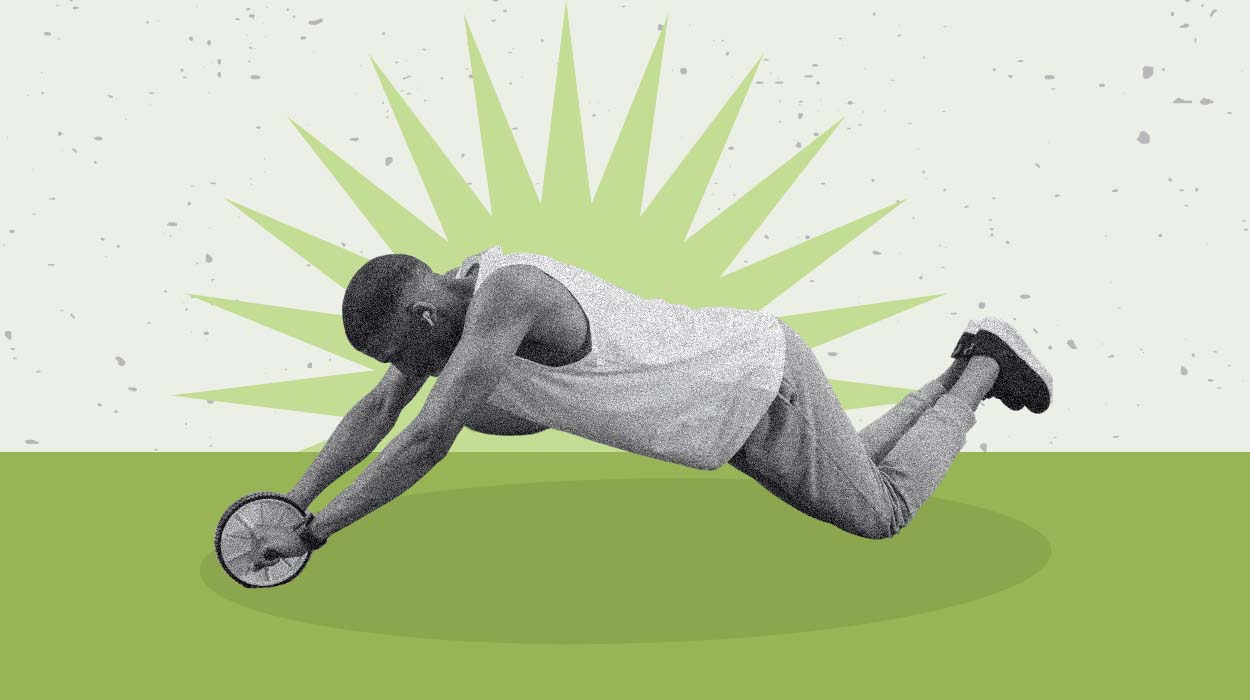
A powerful core isn’t just about having a sculpted six-pack. It is the fundamental support system for your entire body. The stronger your core, the better your stability, balance, and overall athletic performance.
One staple tool in core training is the ab roller. Compact, simple, yet incredibly challenging, these roller wheel exercises work your abs and entire core.
This article will explore the top 10 ab roller exercises to build a strong, sturdy core. These exercises will go beyond the basic roll-out, showing you how to use the ab roller to challenge your stability, strength, and endurance.
Whatever your goal — from weight loss to muscle-building and everything in between — a strong core is crucial. Read on to learn the 10 ab roller workouts to start today.
10 Best Ab Roller Exercises For A Strong Core
Best Ab Roller Workout To Try
For beginners, start with the standard rollout — a great upper ab workout — and gradually add more challenging variations as your core strength improves.
Aim for two to three sets of 10-15 repetitions of each ab roller exercise, depending on your fitness level. As always, remember to keep your movements controlled and your core engaged!
As with any workout equipment, proper form, and technique are crucial when using ab rollers. Always ensure you’re familiar with the basics and have warmed up properly. Let’s roll!
Here are instructions on how to do the top 10 ab roller exercises:
Standard Kneeling Ab Wheel Rollouts
This exercise primarily targets your abdominal muscles, helping you build a strong and stable core. By performing rollouts regularly, you can improve core strength, enhance balance, and promote better posture. Additionally, this exercise engages the muscles in your shoulders, arms, and back, offering a comprehensive upper-body workout.
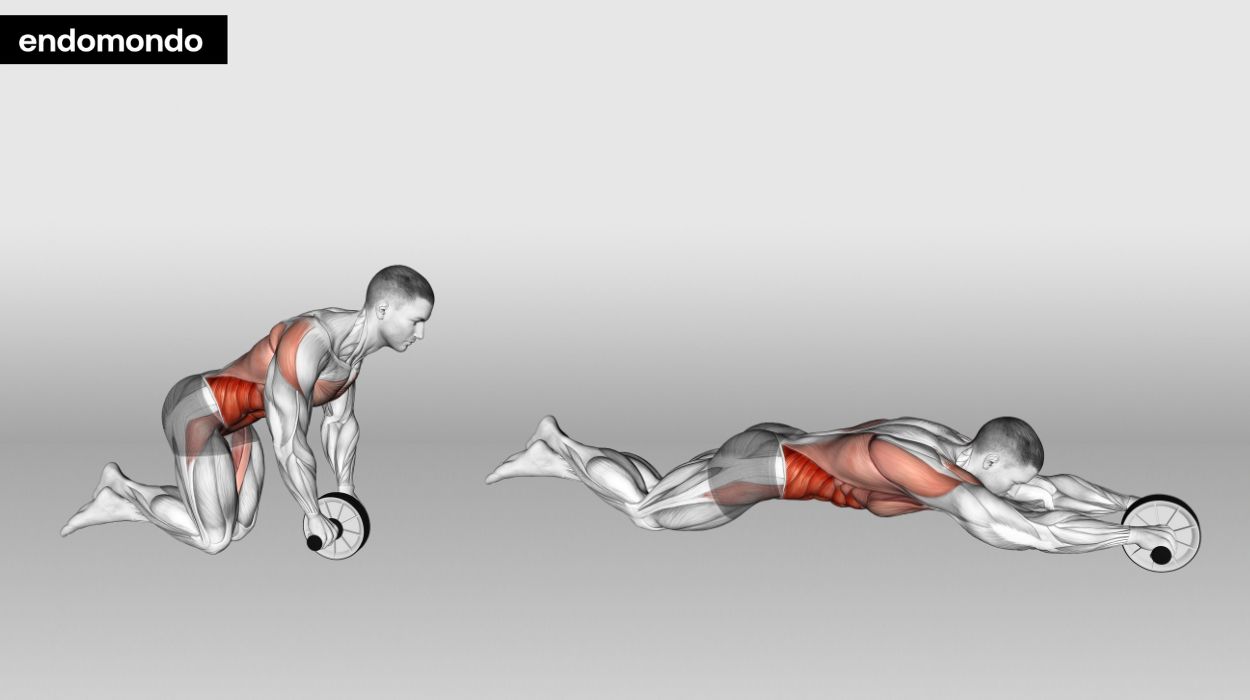
How to do:
- Start in a kneeling position on a mat. Place the ab roller in front of you and hold onto the handles.
- Keep your back straight and slowly roll forward, keeping your abs engaged, and arms fully extended; roll as far as you can without arching or straining your back.
- Roll back to the starting position. That is one rep.
Tips:
- Maintain proper form: Start on your knees with your hands gripping the ab wheel shoulder-width apart. Keep your core engaged, and back straight, and roll out slowly, ensuring your hips don’t sag to avoid straining your lower back.
- Control the movement: Focus on controlling the rollout and the return to the starting position. Avoid going too far out initially; start with a manageable range of motion, then gradually increase it as your core strength improves.
- Breathe and brace: Exhale as you roll out, and inhale as you return. Brace your core throughout the exercise to protect your spine and get the most out of the movement.
Optimal Sets & Reps: 2-3 sets of 8-10 reps
Plank To Pike
The movement of this exercise engages your core, shoulders, and lower back, offering a plethora of benefits. By seamlessly transitioning from a plank to a pike position, you enhance your core strength, improve stability, and target the muscles responsible for a toned midsection.
How to do:
- Start in a high plank position, with your hands directly under your shoulders, and place your feet into the foot straps on the ab roller.
- Using your abs, pull the ab roller towards your hands while lifting your hips to create a V shape. Hold for a few seconds.
- Slowly roll back to the plank position, maintaining control throughout the movement. That is one rep.
Tips:
- Maintain Proper Alignment: When performing the Standard Plank To Pike, keep your body in a straight line from head to heels. Avoid arching your back or letting your hips sag to maximize core engagement.
- Engage Your Core Muscles: Activate your core muscles by pulling your navel towards your spine throughout the movement. This will help you stabilize and control the transition from plank to pike.
- Control the Pike Position: In the pike position, focus on controlled movement rather than speed. Slowly lift your hips, bringing them towards the ceiling while maintaining a strong core, and then lower them back down to the plank position with control.
Optimal Sets & Reps: 3 sets of 10-12 reps
Single Arm Rollout
This exercise helps tone and sculpt your core, enhances functional strength, and promotes better posture. By using a stability ball or roller, you can engage your abdominal muscles, shoulders, and chest while improving balance and stability.
How to do:
- Begin on your knees with the ab roller in front of you. Place one hand in the center of the ab roller and extend the other to the side for balance.
- Keeping your core tight, slowly roll forward as far as you can without losing form.
- Use your core to pull yourself back to the starting position, then switch sides. When you have done both sides, that is one rep.
Tips:
- Maintain Proper Form: When performing the Single Arm Rollout, keep your core engaged and your back straight to prevent lower back strain. This will target your abdominal muscles effectively.
- Start Slowly: If you’re new to this exercise, begin with a few repetitions and gradually increase the range of motion as your core strength improves to avoid overexertion.
- Breathe Steadily: Remember to breathe throughout the movement. Inhale as you roll the ab roller out, and exhale as you return to the starting position for better control.
Optimal Sets & Reps: 3 sets of 8-12 reps
Oblique Tuck
This exercise offers a multitude of benefits, such as sculpting a defined waistline, improving core strength, and enhancing overall stability. By engaging your obliques, you’ll not only achieve a toned midsection but also reduce the risk of back pain and injury in everyday activities.
How to do:
- Begin in a high plank position with your feet in the foot straps of the ab roller. Keeping your upper body stationary, pull your knees towards your right elbow, rolling the ab roller along the way.
- Roll back to the starting position and repeat on the other side. When you have done both sides, that is one rep.
Tips:
- Maintain Proper Form: When performing the Oblique Tuck with an ab roller, keep your back straight and engage your core muscles throughout the movement to prevent lower back strain and maximize the effectiveness of the exercise.
- Control the Roll: Control the rolling motion by using your oblique muscles to pull the ab roller to the side, rather than relying solely on your arms. This will target your obliques more effectively.
- Breathe and Squeeze: Exhale as you tuck your obliques bring the ab roller to the side, and inhale as you return to the starting position. Focus on squeezing your oblique muscles at the peak of the movement for better results.
Optimal Sets & Reps: 3 sets of 10-12 reps
Knee Tucks
The dynamic move of this exercise engages your core muscles, including the rectus abdominis and obliques, helping you build a stronger and more stable core. By incorporating knee tucks into your workouts, you’ll not only enhance your abdominal strength but also improve your overall balance and posture.
How to do:
- This is a great lower ab workout. Start in a high plank position with your hands on the ground and your feet under the foot straps on the ab roller. Engage your abs and pull the roller towards your chest by drawing your knees in. Keep your upper body stationary.
- Slowly extend your legs back to the starting position. That is one rep.
Tips:
- Maintain Proper Form: When performing Knee Tucks with an Ab Roller, keep your back straight and engage your core muscles throughout the movement to avoid straining your lower back.
- Controlled Movement: Focus on controlled, slow movements during Knee Tucks to maximize muscle engagement and prevent any jerky motions that could lead to injury.
- Breathe Properly: Remember to breathe rhythmically; exhale as you pull your knees toward your chest and inhale as you extend your legs back out.
Optimal Sets & Reps: 3 sets of 10-15 reps
V Roll-Outs
This exercise combines the benefits of a traditional plank with a dynamic rolling motion, engaging your abs, shoulders, and chest. By incorporating V Roll-Outs, you can strengthen your core, improve stability, and enhance overall muscle tone.
How to do:
- Start on your knees with the ab roller in front of you.
- Roll the wheel forward and out at a 45-degree angle to your right, keeping your left oblique engaged.
- Slowly roll the wheel back to the starting position, then repeat on your left side. After you have done the left side too, that counts as one rep.
Tips:
- Maintain Proper Form: When performing V Roll-Outs, keep your body in a straight line from head to heels. Engage your core muscles throughout the movement to avoid arching your back.
- Control the Roll-Out: Slowly roll the Ab Roller out in front of you while exhaling, and then use your core muscles to bring it back to the starting position. This controlled movement maximizes the effectiveness of the exercise.
- Gradually Increase Intensity: Gradually increase both sets and repetitions as your core strength improves.
Optimal Sets & Reps: 3-4 sets of 12-15 reps
Standing Ab Wheel Rollout
By incorporating this exercise into your fitness routine, you engage not only your abdominal muscles but also your entire core, including your obliques and lower back. This full-body activation not only helps tone and sculpt your midsection but also enhances your overall balance and posture.
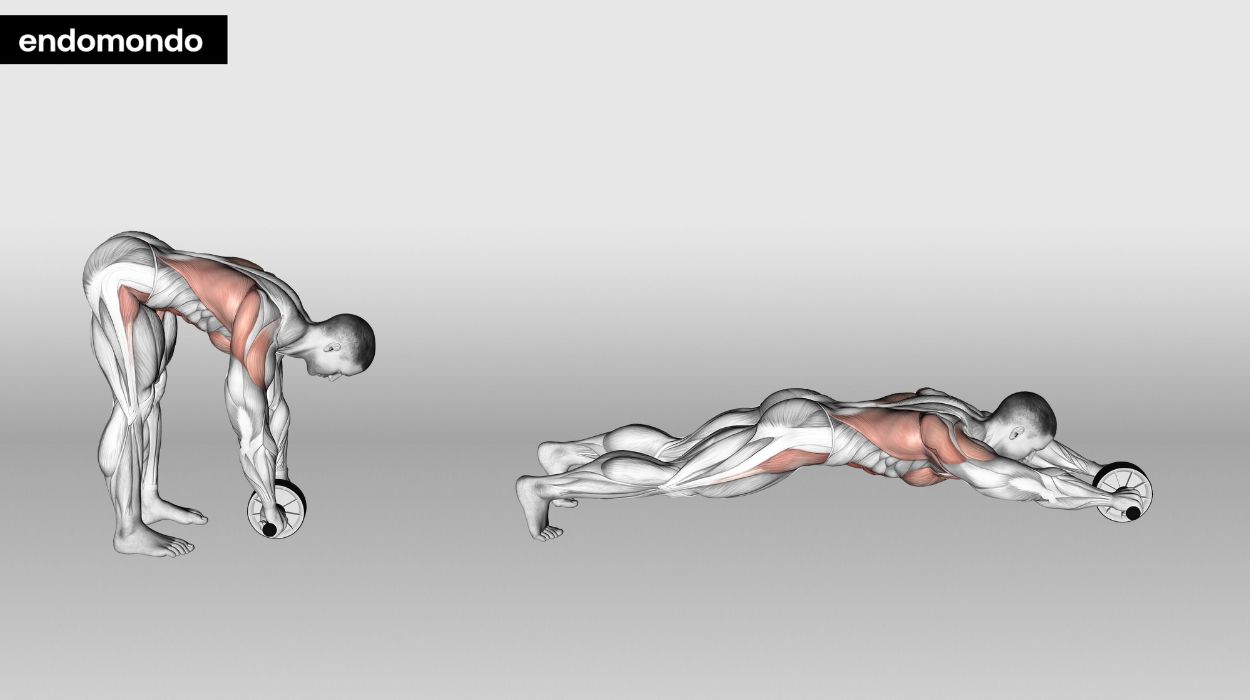
How to do:
- Stand up straight and place the ab roller at your feet.
- Bend at your waist and grasp the handles of the roller. This is your starting position.
- Keep your core tight, grab the ab wheel handles, and roll the ab roller weight forward, keeping your arms fully extended. Go as far as you can without breaking form.
- Roll the wheel back up to the starting position, pulling the roller towards you using your abs. That is one rep.
Tips:
- Maintain Proper Core Engagement: When performing the Standing Ab Wheel Rollout, focus on keeping your core muscles engaged throughout the entire movement. This helps protect your lower back and ensures you’re effectively targeting your abs.
- Start Slow and Controlled: Beginners should start with shorter rollouts and gradually increase the range of motion as they build strength and stability. Keep the movement slow and controlled to avoid straining your muscles.
- Use a Mat or Knee Pads: To prevent discomfort or knee strain, use a mat or knee pads when performing the exercise on a hard surface.
Optimal Sets & Reps: 3 sets of 8-12 reps
Single-Leg Rollout
This exercise engages your core, stabilizes your hips, and strengthens your shoulders and chest. By performing this exercise, you’ll not only enhance your balance and coordination but also target and tone your abdominal muscles, ultimately leading to improved core strength and stability.
How to do:
- Start in a kneeling position with the ab roller in front of you.
- Lift one leg off the ground and hold onto the roller with both hands.
- Slowly roll forward, extending your body into a straight line. Keep your leg lifted throughout.
- Roll the wheel back to the starting position, controlling your movements. That is one rep.
Tips:
- Maintain Proper Form: During the Single-Leg Rollout, keep your core engaged and your back straight to avoid straining your lower back. Focus on the controlled extension of one leg at a time while rolling out, and return to the starting position with control to maximize effectiveness.
- Gradually Increase Difficulty: Start with a manageable range of motion, then gradually extend it as you gain strength and stability. This will prevent overexertion and help you progress safely in your ab roller workout.
- Breathe Properly: Remember to breathe steadily throughout the exercise. Inhale as you roll out and exhale as you return to the starting position to maintain proper oxygen flow and muscle engagement.
Optimal Sets & Reps: 3-4 sets of 10-12 reps
Plank To Push-Up
This exercise helps improve overall stability, builds upper body strength, and enhances your muscular endurance. By incorporating Plank to Push-Up into your fitness routine, you can achieve a strong core, toned upper body, and enhanced functional fitness.
How to do:
- Start in a high plank position with your hands on the roller and legs shoulder-width apart.
- Bend your elbows to lower your body towards the floor, rolling the ab roller towards you as you do so.
- Push up with arms fully extended and roll the ab roller back to the starting position. That is one rep.
Tips:
- Maintain proper form: Start in a plank position with your hands directly under your shoulders and engage your core. When transitioning to a push-up, keep your body in a straight line, and avoid sagging your hips or arching your back.
- Control the movement: Slowly lower yourself into the push-up, and then push back up to the plank position with controlled movements. This helps build strength and stability.
- Breathe rhythmically: Inhale as you go down into the push-up, exhale as you push back up. This helps you stay focused and maintain your energy throughout the exercise.
Optimal Sets & Reps: 3 sets of 10-12 reps
Bridge Hold
By regularly incorporating this exercise into your routine, you can improve your posture, reduce lower back pain, and enhance your overall core strength. Additionally, the Bridge Hold helps increase hip flexibility and can be a valuable addition to your warm-up or cool-down routines.
How to do:
- Lie on your back with your knees bent, feet strapped on the roller, and arms by your side.
- Lift your hips off the ground to create a bridge. This is your starting position. Grab the wheel handles.
- Roll the wheel away from your body, extending your legs. Keep your hips lifted.
- Roll the ab roller back towards your body, returning to the starting position. That is one complete rep.
Tips:
- Proper Form is Key: Maintain a straight line from your shoulders to your knees during the Bridge Hold. Avoid arching your back or sagging your hips to ensure you engage your core effectively.
- Engage Your Glutes: Squeeze your glutes tightly while holding the Bridge position. This not only strengthens your lower back and core but also helps protect your spine.
- Breathe and Hold: Remember to breathe steadily and hold the position for 20-30 seconds as a beginner, gradually increasing the duration as you progress.
Optimal Sets & Reps: 3 sets of 20-30 seconds with 30-60 seconds of rest between sets
Benefits Of Ab Roller Workout
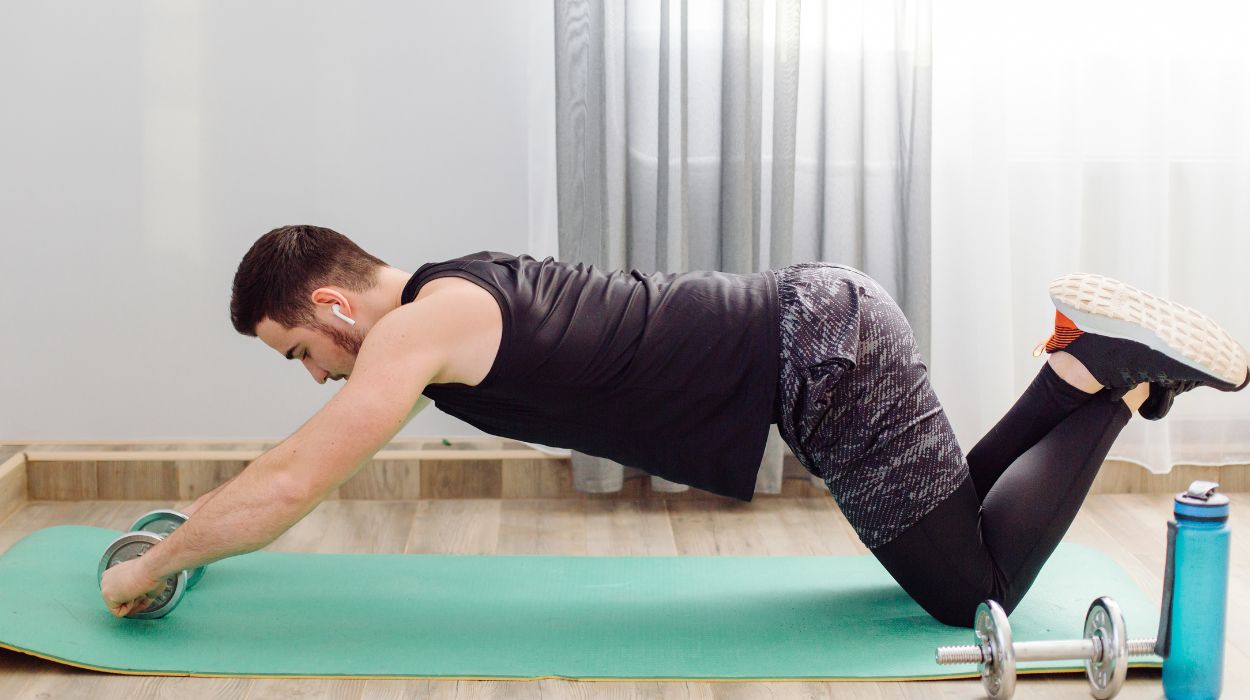
Ab rollers are a valuable and versatile piece of equipment. Here are their main benefits:
- Full Core Engagement: Unlike some core exercises that only target specific areas, the ab roller wheel workout works all your core muscles[1] — the abdominal or six-pack muscles, transverse or deep core muscles, obliques, lower back, and even the muscles around your pelvis.
- Versatility: The ab roller isn’t just for rollouts. You can perform numerous exercises and variations with this single piece of equipment, making it adaptable to all fitness levels.
- Functional Strength: Ab wheel exercises are good for working multiple muscle groups at once. The strength training[2] and stability they provide are useful in everyday activities as well as sports.
- Improved Posture: Regularly working your core can improve your posture. These muscles play a critical role in maintaining the alignment of your spine. Building a stronger core with better posture can also help alleviate back pain.[3]
- Compact And Portable: The ab roller is small, lightweight, and easy to carry. This means you can bring your workout with you, whether you’re traveling, at the office, or simply want a change of scenery from the gym.
- Challenging: Ab rollers require strength, balance, stability, and control. This makes it a good tool for your most challenging core exercises.
- Cost-Effective: Costing between $10-20, ab rollers are relatively inexpensive compared to many other fitness tools. Considering the variety and intensity of the workouts you can perform with it, you’re getting a great bang for your buck.
Safety Tips For Ab Roller Workout
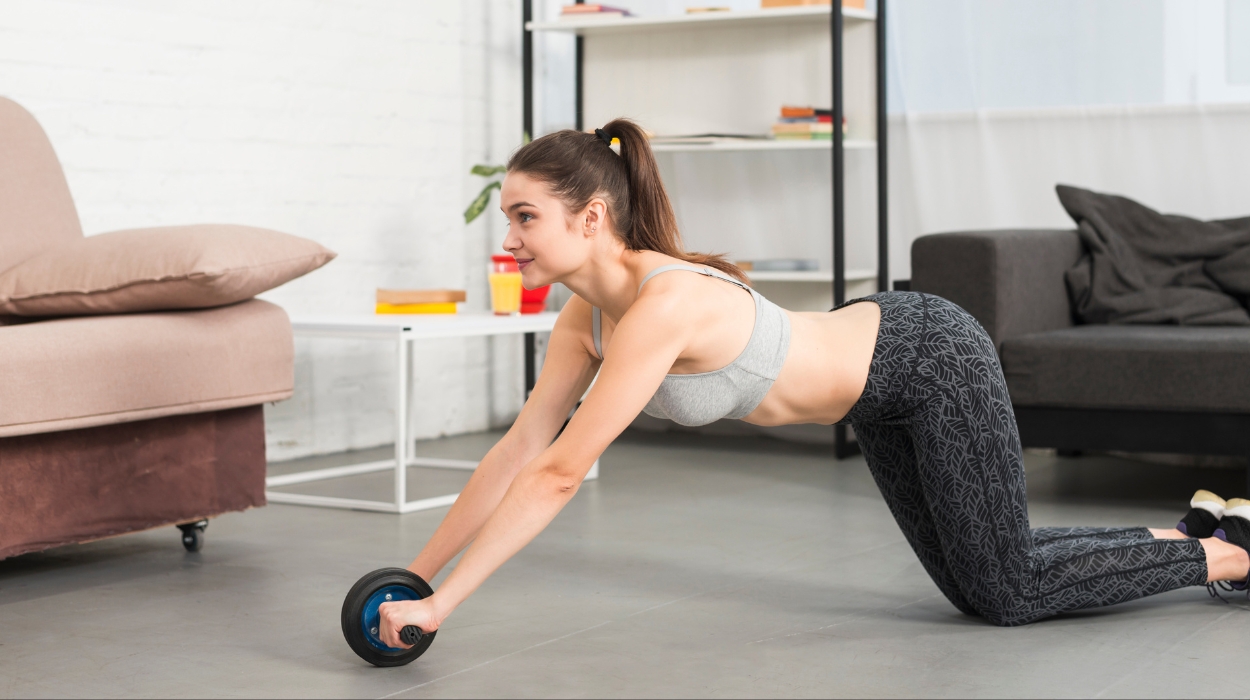
Ab rolling is a fantastic tool for building a stronger core. However, it’s essential to use the tool correctly to avoid injury and maximize its benefits. Here are some safety tips to keep in mind:
Maintain Good Form
Your form is everything when performing ab workouts. Keep your torso straight and avoid arching or hunching. Your head and neck should be in line with your spine. Always engage your core to protect your lower back.
Don’t Rush
It’s not about how many reps you can do but about controlling each rep correctly when doing ab roller exercises. Speed can lead to sloppy form and a weak core, so take it slow and concentrate on muscle contraction and release.
Progress Gradually
Start with the basic rollout. As you gain strength and stability, try more advanced exercises. Trying to perform exercises beyond your strength and fitness level can lead to injury.
Warm Up
Always warm up before your workout. This increases your heart rate, warms up your muscles, and increases your joint mobility.
Listen To Your Body
If an exercise causes pain, stop immediately. A burning sensation in your muscles is okay, but sharp pain or pinching is a sign something is wrong. Never push through pain as this can lead to serious injury. And don’t forget to breathe.
Conclusion
Building a robust and powerful core isn’t just about aesthetics — it’s about enhancing your overall athletic performance and stability and reducing the risk of injury.
The ab roller is an excellent tool to help you achieve this goal, offering a variety of exercises that target not just your abdominal muscles[4] but your entire core. Its benefits will carry over to every aspect of your daily life.
While exercise is crucial for a strong core, a good diet is just as important. If you’re aiming to lose weight while building muscle, certain supplements such as fat burners can help you achieve your goals.
Frequently Asked Questions
A good starting point is two to three sets of 10-15 reps for each exercise. As you get stronger, you can increase the reps or sets.
Yes, the ab roller is an effective tool for core training results. It targets not only your abs but also your lower back, obliques, shoulders, and arms.
The ab roller can help strengthen and tone your abdominal muscles, also known as the six-pack.
While the ab roller is excellent for building core strength and toning your abs, it’s not a magic tool for losing belly fat specifically. Fat loss is best achieved through a combination of regular cardiovascular exercise, strength training, and a healthy diet rich in nutrients.
Resources
- Oliva-Lozano, J.M. and Muyor, J.M. (2020). Core Muscle Activity during Physical Fitness Exercises: A Systematic Review. International Journal of Environmental Research and Public Health, [online] 17(12), pp.4306–4306. doi:https://doi.org/10.3390/ijerph17124306.
- Paulo Henrique Marchetti, Schöenfeld, B.J., Silva, Guiselini, M., de, S., Silvio Luiz Pecoraro, Willy Andrade Gomes and Charles Ricardo Lopes (2015). Muscle Activation Pattern During Isometric Ab Wheel Rollout Exercise in Different Shoulder Angle-Positions. Medical Express, [online] 2(4). doi:https://doi.org/10.5935/medicalexpress.2015.04.04.
- Calatayud, J., Adrián Escriche-Escuder, Cruz‐Montecinos, C., Andersen, L.L., Sofía Pérez‐Alenda, Ramón Aiguadé and José Casaña (2019). Tolerability and Muscle Activity of Core Muscle Exercises in Chronic Low-back Pain. International Journal of Environmental Research and Public Health, [online] 16(19), pp.3509–3509. doi:https://doi.org/10.3390/ijerph16193509.
- Hildenbrand, K. and Noble, L. (2004). Abdominal Muscle Activity While Performing Trunk-Flexion Exercises Using the Ab Roller, ABslide, FitBall, and Conventionally Performed Trunk Curls. Journal of athletic training, [online] 39(1), pp.37–43. Available at: https://www.ncbi.nlm.nih.gov/pmc/articles/PMC385260/




